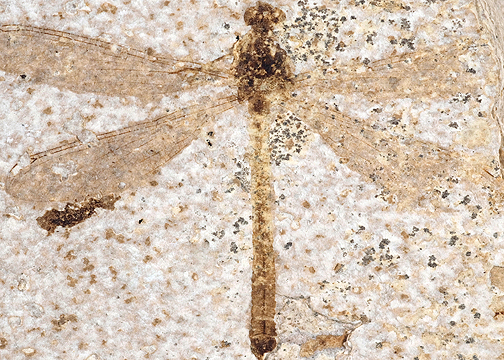Abstract
The Eocene Green River Formation in the USA is well known as a Konservat-Lagerstätte, and has yielded an enormous number of beautifully preserved fossil insects from the Parachute Creek Member of Lake Uinta in Colorado and Utah, USA (Grande, 1984) where insects dominate the fauna. In Fossil Lake deposits, fish dominate the fauna with insects a minor component. This formation spans a 5-myr-long period between ca. 53.5 and 48.5 Ma (Smith et al., 2003) in three distinct basins containing lacustrine sediments. Many of these fossils are in an exquisite state of preservation, occasionally even with soft tissues and colour patterns preserved (e.g., Bechly et al., 2020). As this entomofauna is one of the most diverse for the Early Eocene, increasing its knowledge is crucial for the understanding of the evolution of the insects at that time. This is especially the case for the Odonata, a clade that remains poorly known for the Paleocene and early Eocene (Nel & Jouault, 2022). Bechly et al. (2020) provided a first revision of the damselflies from the Green River Formation, but continuing excavation produces new specimens. The specimen described herein was recently discovered while excavating fossil fish in the Fossil Lake deposits of the Green River Formation in southwest Wyoming. This new species of Zygoptera from the Fossil Lake deposits further demonstrates its impressive diversity of Odonata.
References
- Archibald, S.B. & Cannings, R.A. (2021) The head of Cephalozygoptera (Odonata). Zootaxa, 5047 (1), 97–100. https://doi.org/10.11646/zootaxa.5047.1.10
- Archibald, S.B. & Cannings, R.A. (2022) The first Odonata from the early Eocene Allenby Formation of the Okanagan Highlands, British Columbia, Canada (Anisoptera, Aeshnidae and cf. Cephalozygoptera, Dysagrionidae). The Canadian Entomologist, 154 (e29), 1–8. https://doi.org/10.4039/tce.2022.16
- Archibald, S.B., Cannings, R.A., Erickson, R.J., Bybee, S.M. & Mathewes, R.W. (2021) The Cephalozygoptera, a new, extinct suborder of Odonata with new taxa from the early Eocene Okanagan Highlands, western North America. Zootaxa, 4934 (1), 1–133. https://doi.org/10.11646/zootaxa.4934.1.1
- Archibald, S.B., Ware, J.I., Rasmussen, J.A., Sylvestersen, R.I., Olsen, K. & Simonsen, T.J. (2023) The damselfly genus Furagrion Petrulevičius et al. (Odonata, Zygoptera) from the early Eocene Fur Formation of Denmark and the dysagrionoid grade. Zootaxa, 5278 (2), 289–317. https://doi.org/10.11646/zootaxa.5278.2.4
- Bechly, G. (1996) Morphologische Untersuchungen am Flügelgeäder der rezenten Libellen und deren Stammgruppenvertreter (Insecta; Pterygota; Odonata), unter besonderer Berücksichtigung der Phylogenetischen Systematik und des Grundplanes der Odonata. Petalura, 2, 1–402.
- Bechly, G., Garrouste, R., Aase, A., Karr, J.A., Grande, L. & Nel, A. (2020) The damselfly palaeofauna from the Eocene of Wyoming and Colorado, USA (Insecta, Odonata, Zygoptera). Papers in Palaeontology, 7, 1373–1402. https://doi.org/10.1002/spp2.1346
- Cockerell, T.D.A. (1908) Fossil insects from Florissant, Colorado. Bulletin of the American Museum of Natural History, 24, 59–69.
- Fleck, G., Bechly, G., Martínez-Delclòs, X., Jarzembowski, E.A. & Nel, A. (2004) A revision of the Mesozoic dragonfly family Tarsophlebiidae, with a discussion on the phylogenetic positions of the Tarsophlebiidae and Sieblosiidae (Odonatoptera: Panodonata). Geodiversitas, 26, 33–60.
- Grande, L. (1984) Paleontology of the Green River formation with a review of the fish fauna. The Geological Survey of Wyoming Bulletin, 63, 1–333.
- Huang, D.Y., Liu, Q., Lian, X.N., Fu, Y.Z. & Nel, A. (2022) A new calopterygid damselfly (Odonata, Zygoptera) from the Oligocene Ningming Basin, Guangxi, South China. Palaeoentomology, 5 (2), 113–119. https://doi.org/10.11646/palaeoentomology.5.2.3
- Nel, A. & Arillo, A. (2006) The first Baltic amber dysagrionine damselfly (Odonata: Zygoptera: Thaumatoneuridae: Dysagrioninae). Annales de la Société Entomologique de France, (N.S.), 42, 179–182. https://doi.org/10.1080/00379271.2006.10700621
- Nel, A. & Jouault, C. (2022) The odonatan insects from the Paleocene of Menat, central France. Acta Palaeontologica Polonica, 67, 631–648. https://doi.org/10.4202/app.00960.2021
- Nel, A., Martínez-Delclòs, X., Paicheler, J.-C. & Henrotay, M. (1993) Les ‘Anisozygoptera’ fossiles. Phylogénie et classification (Odonata). Martinia, 3, 1–311.
- Nel, A., Simov, N., Bozukov, V. & Marinov, M. (2016) New dragonflies and damselflies from Middle Miocene deposits in SW Bulgaria (Insecta: Odonata). Palaeontologia Electronica, 19.3.35A, 1–13. https://doi.org/10.26879/642
- Nel, A. & Zheng, D.R. (2021) The recently proposed odonatan ‘suborder’ Cephalozygoptera: fact or fiction. Palaeoentomology, 4 (2), 165–170. https://doi.org/10.11646/palaeoentomology.4.2.5
- Riek, E.F. & Kukalová-Peck, J. (1984) A new interpretation of dragonfly wing venation based upon Early Carboniferous fossils from Argentina (Insecta: Odonatoidea) and basic characters states in pterygote wings. Canadian Journal of Zoology, 62, 1150–1166. https://doi.org/10.1139/z84-166
- Selys-Longchamps, E. de & Hagen, H. (1854) Monographie des Caloptérygines. Mémoires de la Société des Sciences de Liège, 9, i–xi + 1–291. https://doi.org/10.5962/bhl.title.60461
- Smith, M.E., Singer, B. & Carroll, A. (2003) 40Ar/39Ar geochronology of the Eocene Green River Formation, Wyoming. GSA Bulletin, 115, 549–565. https://doi.org/10.1130/0016-7606(2003)115<0549:AGOTEG>2.0.CO;2
- Standring, S., Sánchez-Herrera, M., Guillermo-Ferreira, R., Ware, J.L., Vega-Sánchez, Y.M., Clement, R., Drury, J.P., Grether, G.F., González-Rodríguez, A., Mendoza-Cuenca, L., Botta-Sierra, C.A. & Bybee, S. (2022) Evolution and biogeographic history of rubyspot damselflies (Hetaerininae: Calopterygidae: Odonata). Diversity, 14, 1–16. https://doi.org/10.3390/d14090757


